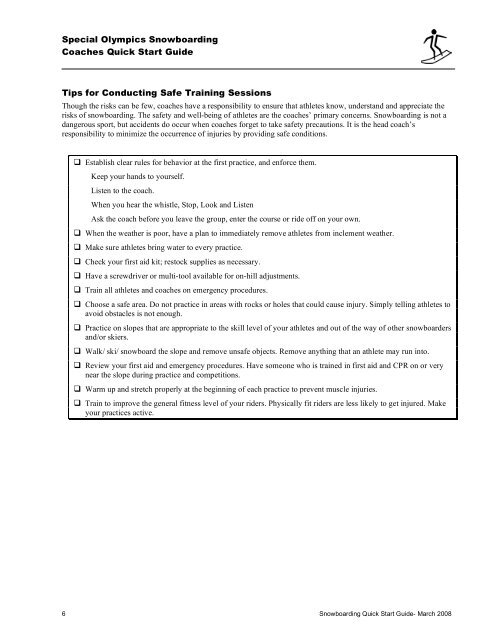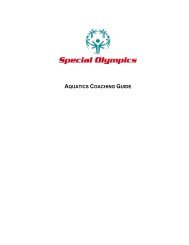N O W B O A R D IN G - Special Olympics
N O W B O A R D IN G - Special Olympics
N O W B O A R D IN G - Special Olympics
You also want an ePaper? Increase the reach of your titles
YUMPU automatically turns print PDFs into web optimized ePapers that Google loves.
<strong>Special</strong> <strong>Olympics</strong> Snowboarding<br />
Coaches Quick Start Guide<br />
Tips for Conducting Safe Training Sessions<br />
Though the risks can be few, coaches have a responsibility to ensure that athletes know, understand and appreciate the<br />
risks of snowboarding. The safety and well-being of athletes are the coaches’ primary concerns. Snowboarding is not a<br />
dangerous sport, but accidents do occur when coaches forget to take safety precautions. It is the head coach’s<br />
responsibility to minimize the occurrence of injuries by providing safe conditions.<br />
� Establish clear rules for behavior at the first practice, and enforce them.<br />
Keep your hands to yourself.<br />
Listen to the coach.<br />
When you hear the whistle, Stop, Look and Listen<br />
Ask the coach before you leave the group, enter the course or ride off on your own.<br />
� When the weather is poor, have a plan to immediately remove athletes from inclement weather.<br />
� Make sure athletes bring water to every practice.<br />
� Check your first aid kit; restock supplies as necessary.<br />
� Have a screwdriver or multi-tool available for on-hill adjustments.<br />
� Train all athletes and coaches on emergency procedures.<br />
� Choose a safe area. Do not practice in areas with rocks or holes that could cause injury. Simply telling athletes to<br />
avoid obstacles is not enough.<br />
� Practice on slopes that are appropriate to the skill level of your athletes and out of the way of other snowboarders<br />
and/or skiers.<br />
� Walk/ ski/ snowboard the slope and remove unsafe objects. Remove anything that an athlete may run into.<br />
� Review your first aid and emergency procedures. Have someone who is trained in first aid and CPR on or very<br />
near the slope during practice and competitions.<br />
� Warm up and stretch properly at the beginning of each practice to prevent muscle injuries.<br />
� Train to improve the general fitness level of your riders. Physically fit riders are less likely to get injured. Make<br />
your practices active.<br />
6 Snowboarding Quick Start Guide- March 2008

















